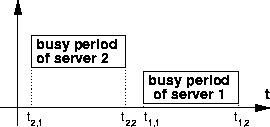
Figure 7: Case 1.
If ![]() , because Server 2 is not busy, the time of
the
, because Server 2 is not busy, the time of
the ![]() -th bit leaving Server 2 can be evaluated as
-th bit leaving Server 2 can be evaluated as
![]()
On the other hand, the time
of the ![]() -th bit arriving at Server 1 can be evaluated as
-th bit arriving at Server 1 can be evaluated as
![]()
By using ![]() , we have
, we have

If ![]() , because Server 1 is not at busy state, the delay
suffered by the traffic of Connection 2 or Connection 3 is bounded by
, because Server 1 is not at busy state, the delay
suffered by the traffic of Connection 2 or Connection 3 is bounded by

If ![]() , the queuing delay suffered by Connection 2 or Connection 3
at this subsystem is zero.
, the queuing delay suffered by Connection 2 or Connection 3
at this subsystem is zero.

Figure 8: Case 2.
First, we consider the situation ![]() .
If
.
If ![]() , the time of
, the time of
![]() bit leaving Server 2 can be evaluated as
bit leaving Server 2 can be evaluated as
![]()
On the other hand, the time of the ![]() bit arriving at Server 1 can be evaluated as
bit arriving at Server 1 can be evaluated as
![]()
So, we have

where ![]() is the length of maximum busy period of Server 1.
If
is the length of maximum busy period of Server 1.
If ![]() , this situation has been discussed in Case 1.
, this situation has been discussed in Case 1.
Finally, we consider the situation ![]() .
Similarly, if
.
Similarly, if ![]() , we have
, we have
![]()
and
![]()
So,

If ![]() , this situation has been discussed in Case 1.
, this situation has been discussed in Case 1.